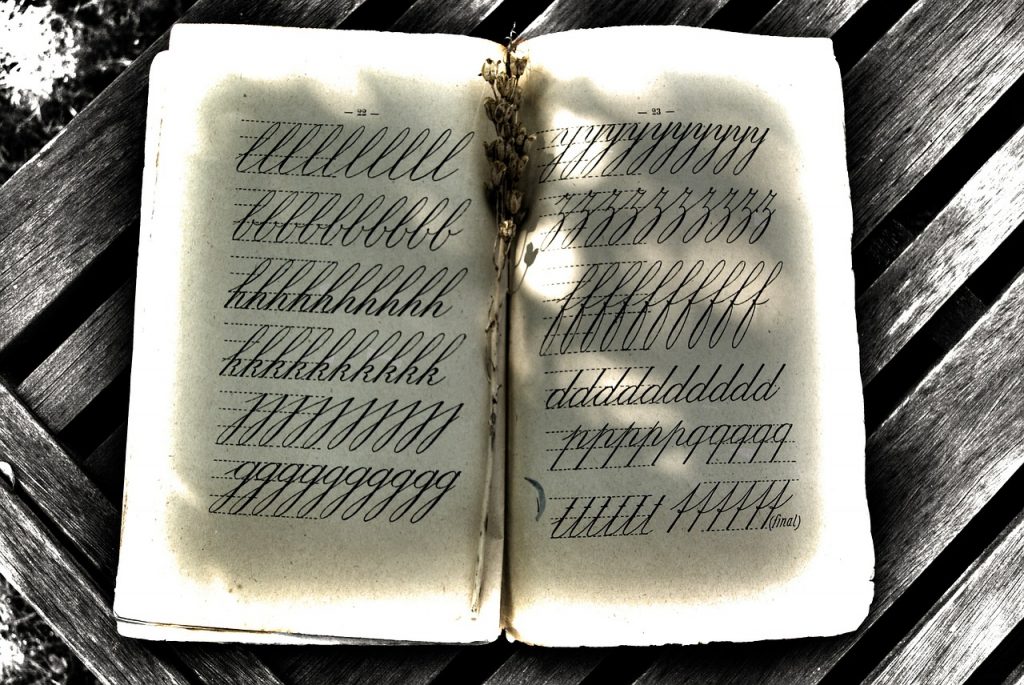The Dying Art of Cursive in English Posted by Gary Locke on May 4, 2017 in Culture, English Language

Cursive is any writing in which the letters are joined together in a flowing manner. In English, we call this penmanship in longhand. It is also known as writing in script. Whatever you call it, this is becoming a disappearing skill.
The letters in English cursive writing always loop, eventually finding and connecting with each other to form words. It evolved from a natural desire to write as quickly, yet legibly, as possible. Longhand penmanship became a commonly required classroom activity in schools in the United States by the beginning of the 20th century. Students would be instructed to repeatedly write the sentence The quick brown fox jumped over the lazy dog. That sentence contains all 26 letters in the English alphabet. Students writing it would learn to write all their letters in longhand. Mastering the difference between capitalized and lower-case letters was the second part of their instruction.
Although there were competing styles, Spencerian and The Palmer Method, to name two, the results often look much the same.
Spencerian penmanship taught students to work with their fingers in rhythmic motions, whereas adherents to the Palmer Method employ their arm muscles to do most of the work. The loops and whorls that we associate with cursive penmanship are as prevalent in one as in the other. In the 1950s it became common to teach students manuscript, or block letter printing first, then introduce cursive later for a more formal approach to handwriting. This was known as the Zaner-Blosser method. The result is often a combination of block letters, usually at the beginning of each word, followed by conjoined letters making up the rest of the word. It ends up looking like someone who can’t decide how they want to write. This is the method that I personally apply to my handwriting, whenever I sign documents or write in longhand – which isn’t often.
And that’s the point. Longhand forms of writing are rapidly falling out of favor because of technology. The keyboard is the universal tool for writing today. Indeed, even the literal keyboard has been superseded by the virtual keyboard found on a smartphone and other electronic devices. Cursive is no longer taught in most schools across the U.S. because it has been deemed by school boards as obsolete. After all, if the original purpose of cursive was to write faster and more legibly, how can it possibly compete with a keyboard? Besides, there are plenty of fonts which enable you to type in cursive.
Curiously, it was the good old typewriter which began the long decline of cursive in the United States. Colleges and universities began to teach typing to their students as early as the 1930s, and class enrollment for studies in cursive penmanship plummeted. By the late 1940s, it wasn’t formally taught at all in academia, which meant that there were no qualified instructors for handwriting to teach it in primary schools. It took school districts several more decades before they realized that the skill which they required students to learn could no longer be taught.
The Future of Cursive
Of course, people still are required to sign documents, keypads, checks and other things. To create a distinctive signature, you probably want to employ some method of cursive writing. Also, some of history’s most important documents are written in cursive. If the skill to write in cursive declines further, will the ability to read cursive become lost as well?
Although writer’s cramp is as real an affliction as carpel tunnel syndrome, as anyone who wrote lengthy letters back home will attest, there’s also a certain motor skill required to write in longhand. You won’t get that from just working your thumbs, texting to friends and family. There are also studies indicating that children who write their papers and tests in longhand retain their learning better than those who only type on a keyboard. Sounds and letter combinations, joined with motor skills and hand/eye coordination, will keep you sharp.
I’ve always looked at English cursive as a kind of drawing of letters, Skilled practitioners of the craft are artists. My father had beautiful penmanship. He used a fine point tip, naturally, as any gifted calligrapher would. I have letters of his which are filled with a flowing, looping cursive, and I’m guessing that he got all As in penmanship at school. He was a Spencerian student, I’m guessing. Comparing letters written in his twenties with those written in his fifties show a broadening skill and flourish with the pen, as different as young Monet was from his later self.
As with any art, it seems, cursive evolves with time. Let’s hope it stays with us, in some fashion, forever.

Build vocabulary, practice pronunciation, and more with Transparent Language Online. Available anytime, anywhere, on any device.




Comments:
Yukiko Repass:
I wish I could write letters in longhand. Someone write in cursive beautifully, I feel the writers personality.